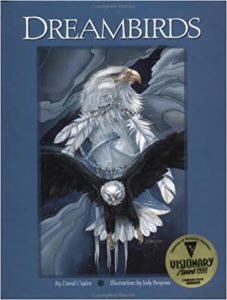Indigenous Perspectives
Dreambirds

Author(s): David Ogden and Illustrator Jody Bergsma
Links:
Amazon: https://amzn.to/3gFaBwV
Indigo: N/A
Social Justice focus: Identity
Synopsis: Natsama is excited when his grandmother tells him about the dream bird. Determined to find a dreambird and claim its mysterious gift, the young boy devotes himself to becoming the greatest hunter and fisherman in his tribe. When he reaches sixteen, the confident young warrior begins his quest, But months pass and he still can’t find one. Only after seeking his grandmother’s guidance does Natsama find his dream bird which teaches him about the importance of humility and taking care of others which means finding his true self.
Lesson Plan: Andre Walker
Primary/Junior/Intermediate Lesson Plan (Abbreviated Template)
Consecutive and Concurrent Programs
Unit/Topic: Social Justice Picture Book
Grade: 8
Lesson: What is the focus of this lesson in relation to the unit? The focus of this lesson is to identify and understand what your true self is and create a rhyming couplet poem to show your understanding. Also this lesson focuses on how expressing your true self gives you confidence.
Curriculum Areas: What are possible connections to other curricular areas?
Health- How students see themselves having a healthy understanding of yourself and identity
Literacy- Writing different forms for different audiences
Art- You could connect this as an art project self-portrait type assignment getting them to use different media to show their image such as using paint, pencil crayons
History- You could connect this with how FNMI cultures may have expressed the importance of showing your true self as they had their land taken away and would want to show their true self so they didn’t lose their culture or customs
Curriculum Expectations: What Overall and Specific Expectations will be addressed?
Language- 1. Generate, gather, and organize ideas and information to write for an intended purpose and audience;
1.2 generate ideas about more challenging topics and identify those most appropriate to the purpose
Health- A1.5 apply skills that help them develop self-awareness and self-confidence as they participate in learning experiences in health and physical education, in order to support the development of a sense of identity and a sense of belonging]
D1.5 demonstrate an understanding of gender identity (e.g., male, female, Two-Spirit, transgender), gender expression, and sexual orientation (e.g., heterosexual, gay, lesbian, bisexual, pansexual, asexual), and identify factors that can help individuals of all identities and orientations develop a positive self-concept
Learning Goal(s): What are students expected to know, do and understand? We are learning to….
We are learning to identify the social justice issue/ theme
We are learning to identify the importance of being yourself
We are learning to create a rhyming couplet poem
We are learning how being yourself gives your confidence
Success Criteria: How will students know they have met the learning goal? I can….
I can identify the social justice issue/ theme
I can identify the importance of being yourself
I can create a rhyming poem using a graphic organizer
I can identify that being myself gives me confidence
MODIFICATIONS/ACCOMMODATIONS: How will I meet the needs of my students? Have I addressed any IEPs?
Students with difficult drawing can use an iPad to help them create an image
If they can’t write a poem they can then write down adjectives to describe them
Minds-on: How will I connect to prior and future learning? How will I engage students and set the context for learning?
Minutes: How much time will I allocate? 10 minutes
Task: What will I be doing? What will students be doing? Get students thinking about what it means to be your true self? Give students a piece paper – ask the students to draw themselves and then ask them to write down some words that they use to define them and if they are comfortable ask a few to share them with the rest of the class
Assessment: What is the Nature and Purpose of assessment? Anecdotal notes
Action: How will I introduce new learning / reinforce prior learning / practice learning / scaffold learning?
Minutes: How much time will I allocate? 30 minutes
Task: What will I be doing? What will students be doing? We will read Dream birds and discuss the theme and social justice topic of being yourself
Ask students about how Natsama saw himself before and after he saw the dream bird?
Ask students about how being your true self could affect them? Ask students do you think that being your self is important to your health? How could it affect your health if you don’t choose to be yourself?
Assessment: What is the Nature and Purpose of assessment? Assessment of learning- Anecdotal notes
Consolidation: How will I reflect on the learning goal? How will I have students reflect on the learning goal?
Minutes: How much time will I allocate? 40 minutes
Task: What will I be doing? What will students be doing? Students will create a pic collage showing their true self using images, words and then write a poem about their true self using the organizer to help them
Assessment: What is the Nature and Purpose of assessment? Assessment for learning- Check brick
MATERIALS: What resources and materials do I need? Where can I find them? In a perfect world what other resources might I need?
Mirrors or reflective surface (If students want to make a self portrait image)
IPad
Marker
Pencils crayons
Blank paper
Graphic Organizer
REFLECTION: Questions to determine the success of your lesson:
- Were my students successful in meeting the learning goals and success criteria? How do I know?
- Did my instructional decisions meet the needs of all students? If not, what are my next steps?
- What worked well and why?
- What will I do differently in the future when teaching this lesson? For the subsequent lesson?
- What are the next steps for my professional learning?

